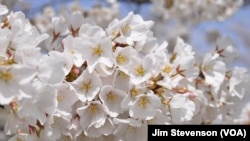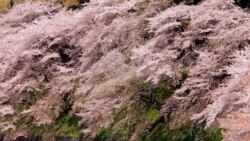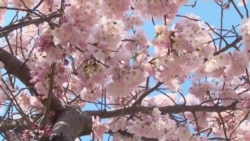WASHINGTON —
Each year nearly one million people visit Washington, D.C.’s Tidal Basin to see the cherry trees in bloom. The trees were a gift from Tokyo, Japan to Washington, D.C. in 1912 and have come to represent the relationship between Japan and the United States. Ann McLellan is the author of two books on the trees "Cherry Blossoms : The Official Book of the National Cherry Blossom Festival and The Cherry Blossom Festival: Sakura Celebration." McLellan spoke with "Now" host David Byrd.
BYRD: These cherry trees were originally a gift to the United States from Japan, right?
MCLELLAN: Yes that’s true. There are about 100 left from more than 3,000 that were gifts from the city of Tokyo to the city of Washington. And they were the result of a Japanese desire to thank the United States for its support of Japan in the resolution of the Russo-Japanese War of 1904-05. Teddy Roosevelt brokered the Treaty of Portsmouth. And it was the first time since (Commodore Matthew) Perry had opened Japan in 1854 that Japan was treated as a bona fide member of the international community – with a real seat at the table. So the trees were a way to acknowledge that, and also I think they were a way for Japan to give something of itself to the United States. The Japanese are so closely associated with the symbol of the cherry blossoms.
BYRD: I wanted to ask you about that symbolism, too. People who visit Washington and see the trees are, of course, captured by their beauty. But do you think that most people realize the almost mystical significance of the trees in Japan?
MCLELLAN: Probably not. Because you can – of course – enjoy them because they are so beautiful all by themselves. But I think that many people once they know the story and they know the symbolism are blown away by it and keep it close to their hearts always and in their memories. What the Japanese have thought of the cherry blossom, as a symbol, is all about how brief life is, to live life fully every minute and to give it your all. The trees bloom on bare branches, so it’s very surprising actually. You know, it’s been a long hard winter and all of a sudden out of nowhere come these beautiful blooms. And it's especially in Japan the trees have found where they can do their best. So it’s both a symbol about how brief life is but it’s also been an inspiring symbol for the samurai, so the whole notion of training for that moment when you have to give your all, or in the course of war in a battle, when you have to do your best. And the ideal would be that you fall on your sword and not wither away because that’s what the cherry blossoms do, you know, all the petals fall at the same time unwithered, so that there’s no wrinkling. If you look at the petals underneath a tree after the petals have fallen, they are all fully formed for the cherry blossoms. And that’s the whole notion of living your life just to the end with full vim and vigor and the best you can.
BYRD: I watched a film called the Tsunami and the Cherry Blossom about the tragic events at Fukushima and other areas in 2011. It talked about how the cherry blossom had become a symbol of the continuity of life -- that life would return even in the midst of unspeakable tragedy. Do you think that this symbol can represent something more when people see it in modern ideas? Or do you think people come to a full appreciation of what it means to someone from Japan versus someone from elsewhere in the world?
MCLELLAN:I think that the cherry blossoms speak to us now just as strongly but perhaps slightly differently than they did before. And I too saw that movie and I thought it was so lovely and poignant that the villagers would go back to visit their tree and what courage they took from it, knowing that the tree was blooming in spite of all the horror that they had endured. But that inspires anybody, even not knowing anything about the idea of what the trees might mean. And I think for us in the United States, we are inspired, too. You know we too have long difficult winters -- both in terms of weather and in terms of things that happen in our lives that are not pleasant or grim or gray -- and so the promise that the trees will bloom, to us, we can accept that too. The promise that things will look better, be better, and be beautiful again is something that we can take to heart – anyone around the world.
BYRD: There is one garden here in Washington – most of the attention is paid to the cherry trees around the Tidal Basin and East Potomac Park – but there is also a memorial off of Louisiana Avenue to those Japanese Americans who were interned during WWII and it also has cherry trees, but I believe some of those are weeping cherry trees. Have you seen that memorial?
MCLELLAN: Yes, and I think that those (trees) are weeping (cherry trees) and what a wonderful way to put that. That was not one of our more glorious moments as a country to intern Japanese American residents during WWII. And many people were very courageous and persevered and went on to survive and in fact, thrive, just as the cherry blossoms do, they live through a horrible winter and then come forth. So I think that is a very lovely, and important, and often overlooked park in our nation’s capital.
BYRD: What do you think is the most important thing about the trees?
MCLELLAN: One of the things that I find is most touching is – I spend a lot of time down by the Tidal Basin really all year round, but especially in the spring when the trees are blooming, and I hear a lot of conversations. And everyone who comes there – whether they are American or whether they come from overseas – and many do come from everywhere in the world just to see the trees around the Tidal Basin blooming – and they all, without even knowing what the story is behind it, they feel the beauty, they take comfort in the notion that life is brief, to make the most of it, and there are so many people who have wonderful family stories – getting engaged or bringing their children there, having wedding pictures taken, walking around with loved ones. And there are photos from WWII and earlier. It’s become a place – it’s almost like a cathedral in nature where people’s prayers and warm thoughts have been captured and almost held by the branches.
The other thing that I always find reassuring about them is that there is a Japanese myth about how the goddess of dawn looked down on the barren winter hills and she took pity on the earth and on all the people and she blew on them and that’s how the cherry trees got their blossoms. So I think that the quality of being compassionate and thinking about others and how we are all connected is very much a part of what the trees mean for everyone.
U.S Park Ranger Brad Berger about what the trees have come to symbolize for millions of visitors to Washington each year in this related video report:
BYRD: These cherry trees were originally a gift to the United States from Japan, right?
MCLELLAN: Yes that’s true. There are about 100 left from more than 3,000 that were gifts from the city of Tokyo to the city of Washington. And they were the result of a Japanese desire to thank the United States for its support of Japan in the resolution of the Russo-Japanese War of 1904-05. Teddy Roosevelt brokered the Treaty of Portsmouth. And it was the first time since (Commodore Matthew) Perry had opened Japan in 1854 that Japan was treated as a bona fide member of the international community – with a real seat at the table. So the trees were a way to acknowledge that, and also I think they were a way for Japan to give something of itself to the United States. The Japanese are so closely associated with the symbol of the cherry blossoms.
BYRD: I wanted to ask you about that symbolism, too. People who visit Washington and see the trees are, of course, captured by their beauty. But do you think that most people realize the almost mystical significance of the trees in Japan?
MCLELLAN: Probably not. Because you can – of course – enjoy them because they are so beautiful all by themselves. But I think that many people once they know the story and they know the symbolism are blown away by it and keep it close to their hearts always and in their memories. What the Japanese have thought of the cherry blossom, as a symbol, is all about how brief life is, to live life fully every minute and to give it your all. The trees bloom on bare branches, so it’s very surprising actually. You know, it’s been a long hard winter and all of a sudden out of nowhere come these beautiful blooms. And it's especially in Japan the trees have found where they can do their best. So it’s both a symbol about how brief life is but it’s also been an inspiring symbol for the samurai, so the whole notion of training for that moment when you have to give your all, or in the course of war in a battle, when you have to do your best. And the ideal would be that you fall on your sword and not wither away because that’s what the cherry blossoms do, you know, all the petals fall at the same time unwithered, so that there’s no wrinkling. If you look at the petals underneath a tree after the petals have fallen, they are all fully formed for the cherry blossoms. And that’s the whole notion of living your life just to the end with full vim and vigor and the best you can.
BYRD: I watched a film called the Tsunami and the Cherry Blossom about the tragic events at Fukushima and other areas in 2011. It talked about how the cherry blossom had become a symbol of the continuity of life -- that life would return even in the midst of unspeakable tragedy. Do you think that this symbol can represent something more when people see it in modern ideas? Or do you think people come to a full appreciation of what it means to someone from Japan versus someone from elsewhere in the world?
MCLELLAN:I think that the cherry blossoms speak to us now just as strongly but perhaps slightly differently than they did before. And I too saw that movie and I thought it was so lovely and poignant that the villagers would go back to visit their tree and what courage they took from it, knowing that the tree was blooming in spite of all the horror that they had endured. But that inspires anybody, even not knowing anything about the idea of what the trees might mean. And I think for us in the United States, we are inspired, too. You know we too have long difficult winters -- both in terms of weather and in terms of things that happen in our lives that are not pleasant or grim or gray -- and so the promise that the trees will bloom, to us, we can accept that too. The promise that things will look better, be better, and be beautiful again is something that we can take to heart – anyone around the world.
BYRD: There is one garden here in Washington – most of the attention is paid to the cherry trees around the Tidal Basin and East Potomac Park – but there is also a memorial off of Louisiana Avenue to those Japanese Americans who were interned during WWII and it also has cherry trees, but I believe some of those are weeping cherry trees. Have you seen that memorial?
MCLELLAN: Yes, and I think that those (trees) are weeping (cherry trees) and what a wonderful way to put that. That was not one of our more glorious moments as a country to intern Japanese American residents during WWII. And many people were very courageous and persevered and went on to survive and in fact, thrive, just as the cherry blossoms do, they live through a horrible winter and then come forth. So I think that is a very lovely, and important, and often overlooked park in our nation’s capital.
BYRD: What do you think is the most important thing about the trees?
MCLELLAN: One of the things that I find is most touching is – I spend a lot of time down by the Tidal Basin really all year round, but especially in the spring when the trees are blooming, and I hear a lot of conversations. And everyone who comes there – whether they are American or whether they come from overseas – and many do come from everywhere in the world just to see the trees around the Tidal Basin blooming – and they all, without even knowing what the story is behind it, they feel the beauty, they take comfort in the notion that life is brief, to make the most of it, and there are so many people who have wonderful family stories – getting engaged or bringing their children there, having wedding pictures taken, walking around with loved ones. And there are photos from WWII and earlier. It’s become a place – it’s almost like a cathedral in nature where people’s prayers and warm thoughts have been captured and almost held by the branches.
The other thing that I always find reassuring about them is that there is a Japanese myth about how the goddess of dawn looked down on the barren winter hills and she took pity on the earth and on all the people and she blew on them and that’s how the cherry trees got their blossoms. So I think that the quality of being compassionate and thinking about others and how we are all connected is very much a part of what the trees mean for everyone.
U.S Park Ranger Brad Berger about what the trees have come to symbolize for millions of visitors to Washington each year in this related video report:







